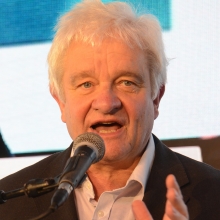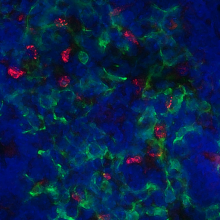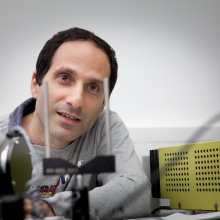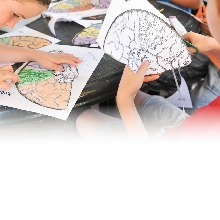A wise future for neuroscience
Weizmann’s flagship initiative will make us smarter than ever about the human brain
Features

Neuroscience is at a critical juncture, with breakthroughs coming at a rapid pace. In the last decade alone, new imaging techniques and tools that allow scientists to see, stimulate, and record brain activity have opened the door to previously unfeasible studies. An explosion of knowledge in genomics has spurred explorations of psychiatric and other brain disorders. Links between the brain and the immune system have led to new ways to think about diseases like Alzheimer’s, and the brain has been shown to be far more malleable than we ever thought possible.
Yet many fundamental mysteries remain unsolved. How do consciousness and cognition emerge from the brain’s complex neural networks? How does the brain respond to everyday experience, and to emotional stress and physical trauma? Why does brain function decline with age, and what are the circumstances underlying mental illness or neurodegeneration?
Paradoxically, these technological advances and bold questions come on the fleeing heels of big pharmaceutical companies, who have found the risk/reward ratio in neuroscience to be too high bear, and the success rate of neurological medicines too low. Achieving the scientific momentum necessary to address the urgent need for solutions demands collaborative, multidisciplinary partnerships that combine excellence in neurobiology with insights from chemistry, physics, linguistics, computer science, and engineering, among other fields.
To take advantage of recent developments and catapult neuroscience research to a new level, the Weizmann Institute of Science is launching a $200 million flagship project, the Institute for Brain and Neural Sciences. It will take shape through the construction of a state-of-the-art building that will serve as a hub for more than 40 internationally renowned groups actively investigating topics of relevance to brain research and neuroscience—including from physicists and computer scientists working beyond the archetypical borders of the life sciences. The building will also house a range of innovative technologies that will allow scientists to explore the brain in entirely new ways.
The Institute for Brain and Neural Sciences will comprise eight integrated research centers and an additional center for new technology development.
It is expected to generate a synergy that leverages the Weizmann Institute’s permeable boundaries between departments, and its small size and informal culture that enable free-flowing interactions and collaborations. And, of course, its great science.
Snapshot of success
The results speak for themselves. The December 2019 issue of Nature Neuroscience—the highest-impact journal in the field—featured a record three articles from one institution, and that institution was the Weizmann Institute. In that issue, Prof. Alon Chen identified four distinct temperaments among mice—comparable to personality characteristics in humans—and linked them to specific genetic profiles, a major step towards enabling scientists to more deeply study mental health and illness in people.
Prof. Rony Paz revealed how emotional learning and memory are represented in the brain by showing that temporal sequences across neurons in the amygdala serve as a coding mechanism. Prof. Ofer Yizhar used cutting-edge optogenetics to track the dynamics of how the brain encodes social sensory cues, with relevance to autism spectrum disorder.
Last October, Prof. Rafael Malach and Prof. Michal Irani caught the interest of the cognitive and systems neuroscience communities with a brain imaging study that revealed the importance of facial geometry in how we perceive human faces. Earlier in the year, Prof. Malach uncovered a neuronal mechanism central to human free recall—rapid ripples of activity across the brain’s hippocampus. The study appeared in Science.
The accomplishments go on. Prof. Michal Schwartz pioneered the theory of ‘protective autoimmunity,’ which attributes a revolutionary role to the immune system in supporting cognitive function, mental stability, stem cell renewal and repair, and in combating neurodegenerative diseases such as Alzheimer’s. Meanwhile, Prof. Nachum Ulanovsky and Dr. Yaniv Ziv made key findings on navigational ‘place cells’ in the brain that have important implications for understanding Alzheimer’s disease and dementia. The initial discovery of these cells garnered the 2014 Nobel Prize in Physiology or Medicine.
Prof. Shimon Ullman, a 2015 Israel Prize laureate, is working to narrow the gap between the visual recognition abilities of humans and the artificial intelligence systems they build. And Prof. Noam Sobel used the Weizmann Institute’s powerful 7-Tesla magnetic resonance imaging system to show that olfaction is possible even in the absence of an olfactory bulb.
Accelerating multidisciplinary research
The Institute for Brain and Neural Sciences will accelerate multidisciplinary research by gathering the diverse neuroscience knowledge, expertise, and infrastructure at the Weizmann Institute into a greater, collaborative, and integrated whole—creating a unique environment of physical proximity that promotes robust synergistic energy and catalyzes discovery for the benefit of humanity.
Scientists at the Weizmann Institute of Science has contributed to over 500 articles of relevance to neuroscience in the last five years alone, and several of those papers have already been cited hundreds of times. From base pairs to bedside, from the emerging field of artificial intelligence, to technological advances in disease modeling and illuminating the neural landscape, neuroscience stands at a precipice. With the establishment of the Institute for Brain and Neural Sciences, Weizmann is ready to soar.
Centers of Investigation
The Development of Neural Networks
The adult brain is a complex network of roughly 100 trillion connections among billions of neurons. Proper functioning of this network demands an efficient wiring of circuits, optimized yet flexible enough to handle the uncertainties of daily living.
How does the brain, with all of its complex neural networks, develop? What happens when the process goes awry?
Scientists will aim to reveal how the diversity of specific types of neurons emerge during development, how neurons migrate to their correct locations, and how neurons’ extensions are guided over long distances to find their targets. Topics will include understanding the formation of neural connections (synapses), remodeling of synapses and circuits, development of sex differences in neural networks, the role of neural support cells, as well as neuronal metabolism.
This research will lead to a better understanding of the pathology underlying a variety of diseases and disorders from epilepsy and fragile X syndrome, to a range of mental illnesses.
Perception and Action
Humans have an insatiable appetite for sensory input—whether conscious or unconscious. Sensory perception provides the immediate ingestion of information, driving our behaviors as we seek out the new.
How do we sense, and how does the brain combine input from different sensory modalities to form a coherent picture?
Weizmann scientists are exploring a variety of forms of sensory processing to clarify how sensory input translates into action. They are also working to unveil the process of motor action—from the decision to take an action in higher brain areas, to the execution of a movement via commands transmitted to the spinal cord, followed by muscle activation.
This research will improve our understanding of sensory disorders and motor diseases, and contribute to efforts to develop sensory substitution techniques, alleviate chronic pain, and develop artificial sensing technologies, such as robotic arms and brain-machine interfaces.
Mental and Emotional Health
More than 7 percent of global life expectancy years lost to illness, disability, or premature death are caused by mental illnesses, including depression, anxiety, schizophrenia, and bipolar disorder, among other debilitating conditions.
What prompts mental illness, what promotes resilience, and how can we manipulate these processes?
Scientists in this center will employ integrated molecular, biochemical, genetic, and behavioral methods in state-of-the-art preclinical models to investigate neural pathways. Others will use psychophysics techniques and brain imaging technology in humans and electrophysiology in animal models to unveil emotion-related networks at the level of individual brain cells and understand how these networks malfunction in mental illness.
Insights expected to emerge from this center will bolster mental resilience, prevent mental illness, and inform the design of new targets for brain-based treatment when illness does occur.
Learning, Memory, and Cognition
The hallmark of human evolution is sophisticated cognitive function.
How do our brain make us who we are—and how can we ‘fix’ the brain when this activity falters?
Scientists will seek answers to these questions and their relevance to cognitive impairments, dementia, amnesia, learning disabilities, and mental illness.
The human brain makes complex computations that far outstrip the capacity of any modern machine. The process of working memory, the impact of attention, and the consolidation and storage of some memories while others are suppressed or erased are all part of this complexity. Add to that optimal decision-making (encompassed in the emerging field of neuroeconomics). Additionally, addressing these issues and more requires an integrated study of brain activity that combines insights from neuroscience, and computer scientists will also pave the way towards advanced machine learning and ‘smart’ technologies that are at the heart of artificial intelligence.
The Aging Brain
As science and medical technology continue to expand the human lifespan, societies and individuals must face the inevitable consequences: the physical and mental deterioration of healthy aging, not to mention the increasing prevalence of age-related neurodegenerative diseases.
How does the brain transform in the aging process? Can this process be halted or reversed?
Through extensive collaboration across fields and disciplines, Weizmann scientists will advance our understanding of what drives the aging process and the physiological results of brain aging—in health and disease—and are expected to yield potential treatments for aging-related disorders.
This center will work in collaboration with the Sagol Institute for Longevity Research, which investigates brain and body biology related to aging and longevity.
Neurodegeneration
Alzheimer’s disease, Parkinson’s disease, amyotrophic lateral sclerosis, multiple sclerosis, and Huntington’s disease are all characterized by inexorable loss of cognition and memory, changes in behavior, and an inability to control bodily functions. Research to prevent and repair neurodegeneration is a priority for science and for medicine.
What are the causes and trajectories of neurodegenerative diseases? How can they be prevented and cured?
Finding solutions to the challenges of neurodegeneration will lie at the heart of research conducted in this center, which will serve as a platform for the discovery of basic mechanisms of brain integrity, their failure in neurodegeneration and the potential means of amelioration. Research will leverage the developmental, sensorimotor, memory, and aging advances of its sister centers, and return key insights into the molecular, cellular, genetic, and systems-level mechanisms fundamental to how the nervous system functions.
Injury and Regeneration
Unlike the expansive growth and adaptation of neurons in early development, central nervous system neurons undergo little or no regeneration following injuries, such as those to the spinal cord, that occur during adulthood. This failure of resilience has been attributed to a combination of inhibitory extrinsic factors—such as traumatic injury—as well as the loss of intrinsic growth ability.
What happens to the nervous system when it is injured? How can we repair damage to the brain and spinal cord?
Scientists will work to understand the role of these intrinsic and extrinsic factors, which may shed light on how to convince damaged neurons to regenerate. Research will address such fundamental questions as the response to injury and the growth potential of damaged neural tissue. Researchers will also draw insights from organisms such as fish and amphibians, who regenerate neurons with far greater efficiency than mammals do.
Theoretical and Computational Neuroscience
Theoretical and computational neuroscientists ask questions about the principles that underlie the design of neural circuits, neural coding, and information processing in the brain—and the resulting impact on behavior. Their research aims to reveal how neural circuits form, how they function, and how they learn, and how they might be corrected when damaged—or even improved.
What is the ‘language’—the neural code—used by the hundreds of billions of neurons in the brain? How does this language enable the brain to perform the sophisticated computations that make us human?
Researchers in this center will employ mathematical tools taken from statistical physics, dynamic systems, machine learning, and information theory to create new models and theories of brain function, and engage in intense collaborations with experimental laboratories.
The resulting computational tools for analyzing ‘Big Data’ will open up new experimental frontiers, while theoretical models for understanding the design and function of neural circuits will inform both pathology and drug design. Ultimately, it will reveal the ways in which ‘bugs’ in the neural code underlie neurological disease.
Development of Innovative Technologies
Weizmann scientists have an extensive history of developing groundbreaking technologies that have been implemented throughout the international neuroscience community. This center will leverage that expertise as a hub for the development of new technologies and techniques that are necessary to accelerate the pace of discovery across all the centers in the Institute for Brain and Neural Sciences.
The creation of such technologies require close collaboration among biologists, physicists, chemists, engineers, and computer scientists. These experts will work together to identify specific problems, brainstorm solutions, and then design and build these solutions.








